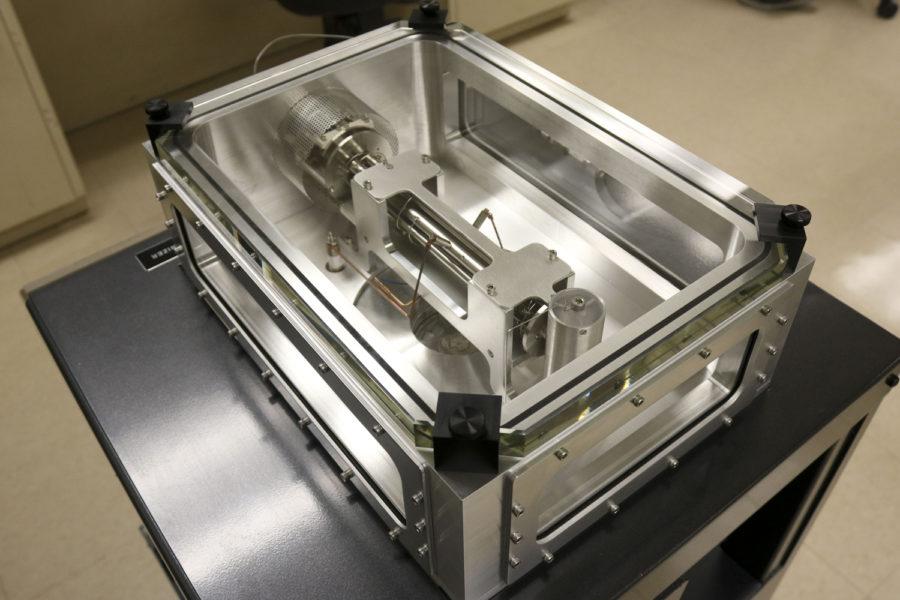Pitt’s Department of Physics and Astronomy has received a new gadget that will help students make massive academic strides in the near future.
Pitt acquired Extrel’s educational mass spectrometer, IQ-2000, in October. The device — which identifies gases based on their molecular mass to charge ratio — will allow physics majors to develop their understanding of electricity and magnetism by exposing them to these concepts in their laboratory course sections.
Steven Dytman, a Pitt professor who has taught Modern Physics for about 25 years, said the mass spectrometer has become key to scientific research and an important educational device in physics.
“Every lunar lander that wants to go to the moon and sample the surface, sample the air, they always have a mass spectrometer. It is an absolutely essential part of biological research, chemical research,” Dytman said.
Aware of this importance, Istvan Danko, a lab instructor for the department of physics and astronomy, and Dytman, applied for a $20,000 grant from the University of Pittsburgh to purchase Extrel’s mass spectrometer. Extrel, a local Pittsburgh company founded by former University of Pittsburgh Professor Wade Fite, develops gas analyzers for research and industry, which universities can purchase to improve laboratory curriculum.
According to Dytman and Danko, there was a consensus in the department to find a replacement for the old mass spectrometer three years ago, but additional funding was needed at the time to purchase this type of device. Originally, the new mass spectrometer cost $60,000. However, after a 20 percent discount and an educational grant from Extrel, the price was brought down to $28,000, which was shared between the University of Pittsburgh and the department.
“It’s not cheap,” Dytman said. “On the other hand, [the students] get to use some fairly interesting equipment at a young age, and we think that’s wonderful.”
Jen-Feng Hsu, a postdoctoral associate at Pitt, was a teaching assistant for the Modern Physics laboratory course when the old mass spectrometer was retired. He said that the device was difficult for students to use and extract data from. During his time working with the old device, Hsu was involved in helping students conduct laboratory experiments.
“[The mass spectrometer] is a highly selective filter for a certain charge and mass combination, so this is how you precisely know the mass of a composite gas sample,” Hsu said.
When compared to the new mass spectrometer, Hsu said the old mass spectrometer was difficult to use, had poor resolution and was not as portable because of its large size. The new mass spectrometer has dimensions of 2.5 by 2.7 by 2.1 inches — without the cart — and weighs 130 lbs. It’s significantly smaller than its older counterpart, which had dimensions of about 4 feet long, 3 feet wide and 4 feet deep, and was immobile because of its weight and cables.
Hsu also said the new device’s computer interface will make it easier for students to use and will prepare them for work in actual research laboratories.
“Having a mass spectrometer is very good practice or an educational opportunity for the student who is taking the lab,” Hsu said. “With this new module I can see that it is modernized and it has a much better computer interface.”
While the old mass spectrometer hadn’t been in use for the last three years, the professor and the lab instructor have developed several experiments involving the new mass spectrometer for students to learn from. Some of the laboratory experiments the students could conduct include analyzing how abundant certain isotopes are in comparison to other isotopes of the same element, the electric fields within the device and the motion of the particle because of the electric field.
The IQ-2000 Mass Spectrometer will mainly be used in physics laboratory courses as a teaching device for physics students. In these advanced laboratory-level courses, the device was previously used to determine the ratio of the mass of an element in a molecule to the mass of a molecule. Students can now use the device to gain firsthand exposure to its operation and to analyze the data it provides to determine the identity and composition of the gas.
“We are really excited to have this equipment,” Danko said. “It is a really state of the art mass spectrometer. It is a really good opportunity for physics majors, physics students to see how to put the principles of electricity and magnetism to use.”
Danko said the previous mass spectrometer used by the department was between 30 and 40 years old and was broken beyond repair due to its old age. According to Danko, one of the issues the old mass spectrometer faced was with its vacuum system.
Danko went on to explain how the mass spectrometer functions. It acts like a small accelerator, charging small particles of gas using electrons. These ionized particles pass through a magnetic field, which allows the user to obtain an analysis of the particles’ mass and mass to charge ratio. This information can later be used practically to identify a gas, detect impurities during production processes or even check for leaks in vacuum furnaces.
“[Mass spectrometers] have a very basic principle that is based on electricity and magnetism, Danko said. “[This is] very useful to see for physicist and physics majors, how all these things are operated and how you can use these principles in a practice.”
Dytman said the device carries educational value because the principles of electricity and magnetism, which are necessary for the device to function, can develop a physics students’ understanding of electricity and magnetism by using the device as part part of their laboratory curriculum.
“It’s an honors course and only the best students take it, but we do get some of the best students in the science part of university,” Dytman said. “They are very eager to learn and very curious, and we want to give them the very best equipment we can.”



